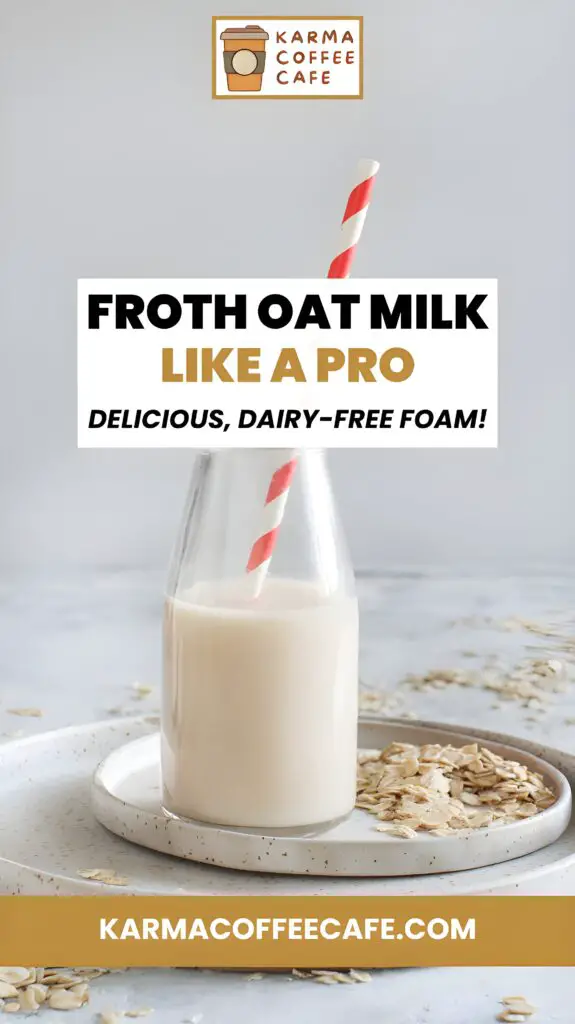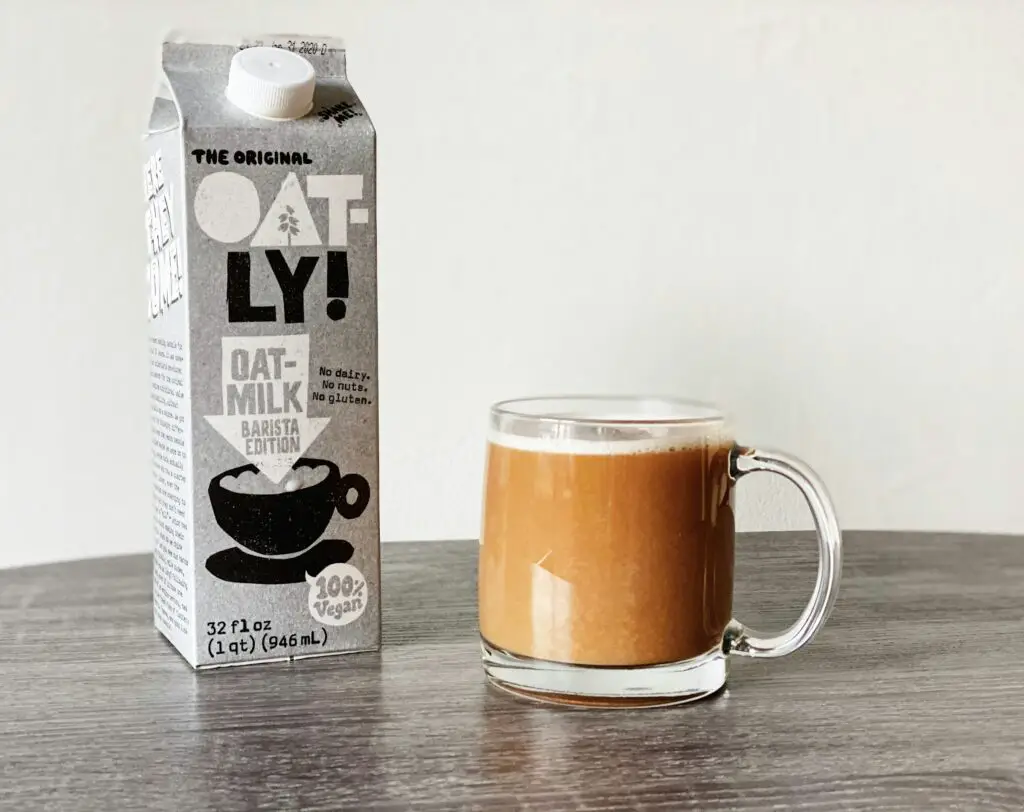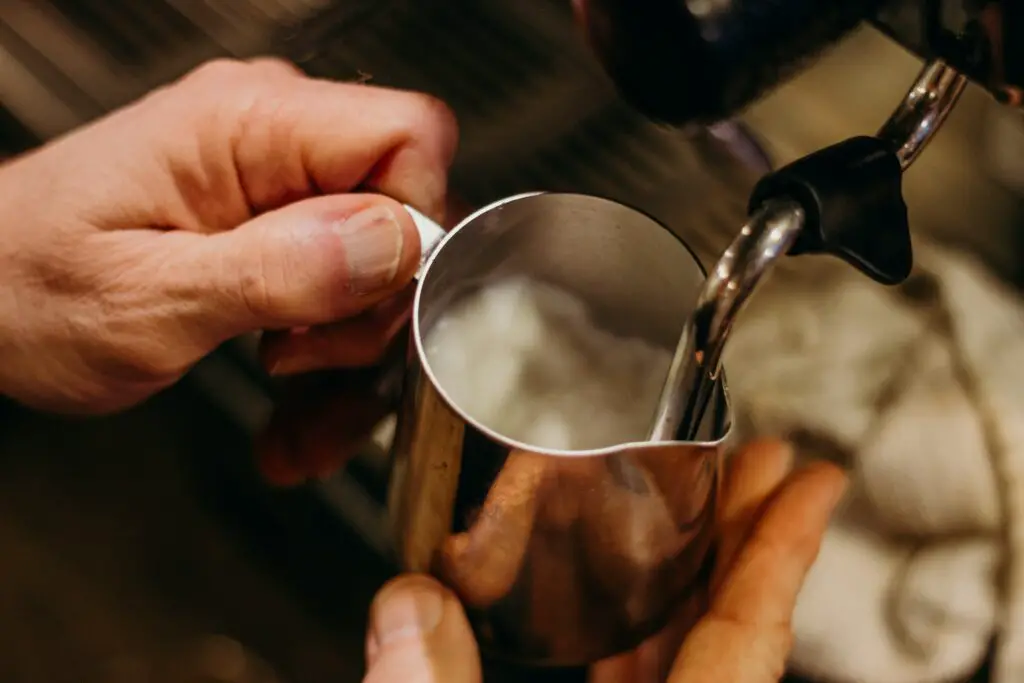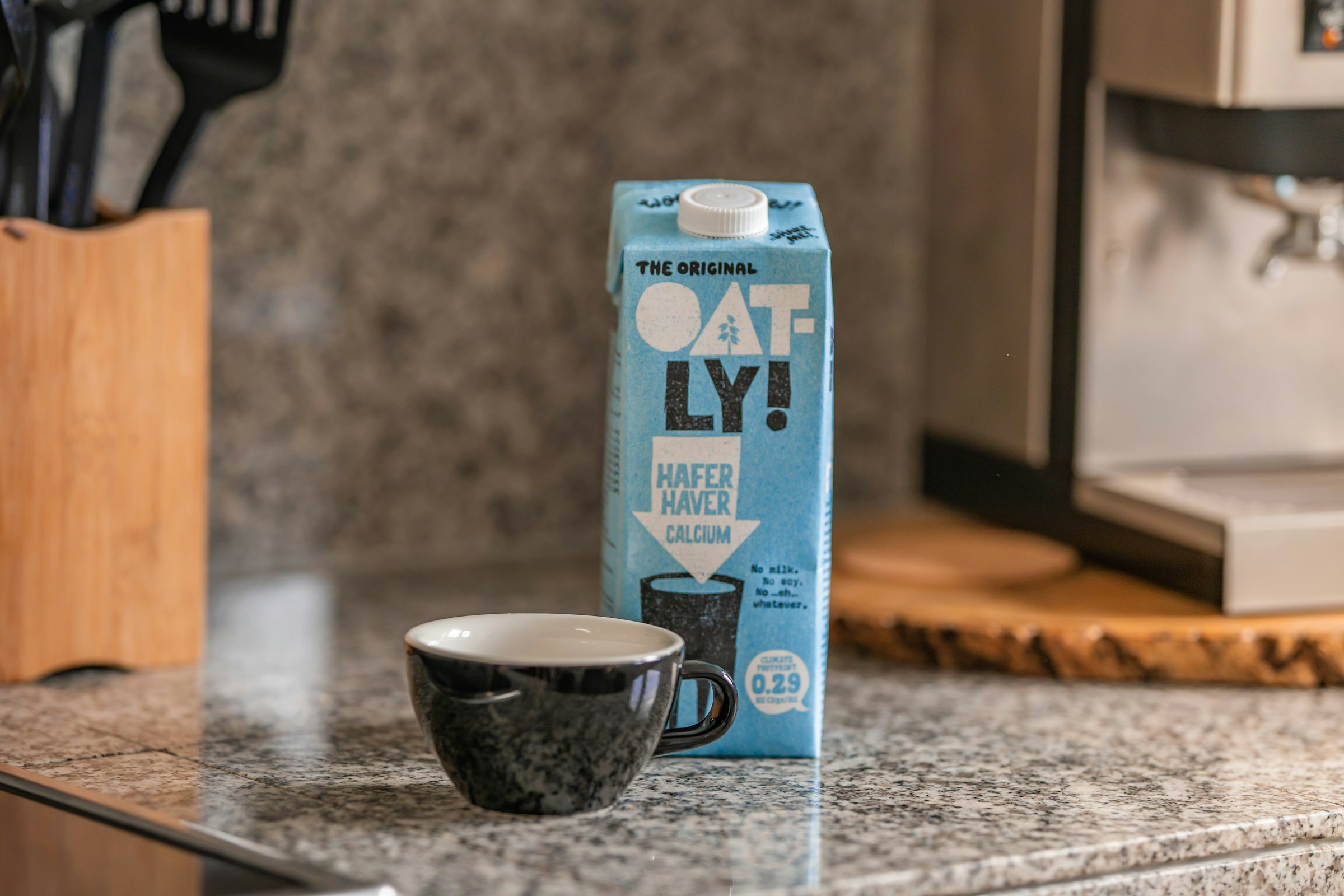If you’ve been wondering whether it’s possible to achieve that creamy and velvety froth with oat milk, you’re in the right place.
In this concise guide, we’ll delve into the secrets of frothing oat milk to perfection, uncovering essential tips and techniques that will elevate your barista skills to new heights.
Whether you’re a coffee enthusiast, a latte lover, or simply seeking a dairy-free alternative, let’s explore the possibilities and unlock the art of frothing oat milk like a pro!

Can You Froth Oat Milk?
Yes, you absolutely can froth oat milk to create delightful coffee drinks!
Among various plant-based milk options, oat milk stands out for its natural thickness and creaminess, making it an ideal choice for lattes and macchiatos that closely mimic the texture of dairy milk.
There are multiple methods to froth oat milk, giving you the flexibility to choose what suits you best.
For those with a blender or food processor, frothing oat milk is a breeze.
Just pour the oat milk into the device and set it to the highest speed for a quick and easy froth.
If you’re an espresso machine owner, take advantage of its steam wand to froth oat milk, achieving a velvety consistency perfect for latte art and other coffeehouse favorites.
Additionally, you can invest in a standard milk frother, specially designed to froth oat milk with ease.
To ensure optimal results, it is recommended to use oat milk specifically formulated for frothing, as it guarantees a smoother and more efficient frothing process compared to regular oat milk.
What Exactly Is Oat Milk?

Oat milk, a popular plant-based milk alternative, is derived from whole oat grains through a simple extraction process with water.
Its unique creamy texture and mild oatmeal-like flavor make it a delightful choice for various applications.
Available in an array of flavors, including sweetened, unsweetened, vanilla, and chocolate, oat milk has quickly gained popularity as a versatile ingredient in custom coffee preparations and fermented products like yogurt and kefir.
Compared to other plant-based milks like almond or rice milk, oat milk boasts a slightly higher protein and fiber content, making it a nutritious option for health-conscious individuals.
An important note for those with gluten sensitivity or celiac disease: while oats themselves are gluten-free, they are often processed in facilities shared with other gluten-containing grains, posing a risk of cross-contamination.
Therefore, it’s essential to look for certified gluten-free oat milk if you need to avoid gluten.
Crafting oat milk at home is possible by blending rolled oats and water together, followed by straining the mixture through a clean t-shirt or towel.
Store-bought oat milks may contain added sugar, oils, stabilizers, or gums, so it is recommended to choose brands with a short ingredient list for fewer additives.
Unraveling the Art of Milk Frothing

Milk frothing is a captivating process that involves aerating milk to achieve a light and foamy texture, commonly used as a delightful addition to coffee drinks like cappuccinos and lattes.
The magic lies in introducing air into the milk’s chemical properties, resulting in the creation of frothed or foamed milk with a distinct texture and taste.
Comprising proteins, fats, and carbohydrates, milk’s frothiness is largely influenced by its fat and protein content.
Whole milk, with higher fat and protein levels, produces a richer and thicker froth.
The proteins found in milk, namely whey and casein, play a key role in creating the froth, and their structures influence the foam’s overall consistency.
The frothing process primarily revolves around temperature.
As milk is heated to around 140 degrees Fahrenheit, the proteins work cohesively to maintain a stable froth.
However, surpassing this temperature threshold leads to protein denaturing, altering the froth’s structure and texture.
Due to these intricate factors, various types of frothed milk can be achieved, making the art of milk frothing an essential and exciting step in crafting coffee shop-worthy beverages.
Mastering this technique unlocks a world of possibilities to elevate your coffee experience with velvety, foam-topped creations.
Various Techniques for Frothing Oat Milk
Frothing oat milk might seem challenging, but fear not! There are multiple methods you can employ to achieve that perfect, creamy texture.
Let’s dive into detailed instructions for each method:
Using a Steam Wand

- Fill a milk pitcher with oat milk, leaving some room for expansion.
- Ensure the steam wand is clean and ready to use.
- Submerge the wand just below the milk’s surface and turn on the steam.
- Keep the wand steady until the milk reaches a maximum temperature of 55°C/130°F.
- Continuously spin the milk to avoid overheating.
- Once heated, tap the pitcher to remove any large bubbles and swirl the milk for a smooth texture.
Using a Blender or Food Processor

- Pour oat milk into the blender or food processor and set it to the highest speed.
- Blend until the milk froths to your desired consistency.
- Be cautious not to overfill, as the milk will expand during frothing.
Using a French Press or Mason Jar

- Pour cold oat milk into the French press or mason jar.
- Vigorously pump or shake it for 30-60 seconds until the milk doubles in size.
- This method works best with cold milk.
Using a Hand Pump Frother

- Heat oat milk in a microwave-safe bowl to a scalding temperature (around 65°C/150°F).
- Fill the frothing pitcher or carafe, leaving about 2/3 empty.
- Pump the device with quick, short plunges for 10-15 seconds, moving it vertically to create froth.
- Continue until you achieve the desired foam.
Using a Hand Whisk

- Warm oat milk and pour it into a bowl.
- Vigorously whisk for a few minutes until froth forms.
- Transfer the frothed oat milk into a pitcher.
Important To Note
Remember to use the right amount of oat milk and shake it well before frothing to ensure proper blending with thickeners.
Be patient and practice to master the desired texture.
Why Is Oat Milk A Great Alternative For Coffee?
Oat milk is a fantastic option for those who are lactose intolerant, and many oat milk brands are gluten-free.
When comparing milk alternatives to dairy milk, oat milk is the most similar option.
Let’s explore some of the main reasons why Oat milk is great for coffee lovers:

Taste and Texture
Oat milk’s popularity in coffee lies in its exceptional taste and texture.
With a rich and creamy flavor akin to cow’s milk, oat milk harmoniously complements the complexities of coffee, adding a touch of natural sweetness without overpowering its distinct taste.
Unlike certain milk alternatives that can be overly sugary, oat milk strikes a perfect balance, making it an ideal choice for your daily brew.
Environmental Impact
Choosing oat milk for your coffee is not just a matter of taste; it’s also an environmentally conscious decision.
Compared to dairy milk, oat milk boasts a significantly lower environmental footprint.
Dairy milk production requires ten times more land than oat milk production, making the latter a more sustainable choice.
By opting for oat milk as a dairy alternative, you contribute to a more eco-friendly coffee routine.
Health Benefits
Beyond its taste and environmental advantages, oat milk offers various health benefits.
It serves as a reliable source of essential nutrients like vitamins B12, magnesium, calcium, and potassium.
Being naturally lactose-free and cholesterol-free, oat milk presents a suitable option for individuals with dietary restrictions or specific dietary preferences, ensuring a guilt-free coffee indulgence.
Versatility
One of oat milk’s greatest attributes is its versatility in coffee beverages.
Whether you’re craving a velvety latte, a refreshing iced coffee, or other coffee shop favorites, oat milk seamlessly blends into various concoctions, delivering a consistent and delightful experience.
Some brands even offer ready-to-drink canned oat milk beverages, making it a convenient on-the-go option for your coffee adventures.
Steamed Milk vs Frothed Milk: What’s The Key Difference?

Steamed milk and frothed milk are both used in coffee drinks, but they have different textures and are made using different methods.
Steamed milk is created by exposing milk to pressurized steam, which causes the fats in the milk to expand and create foam.
This foam is called microfoam, and it has very small air bubbles that make the milk heavier and give it a velvety texture.
On the other hand, frothed milk is created by adding air to milk to change its texture.
The air bubbles in frothed milk are much larger, with a larger volume and a much lighter feel.
Frothed milk is like steamed milk in that you are adding air to change the milk’s texture, but that’s where the similarities end.
Baristas typically refer to frothed milk as “drier” than steamed milk because it contains more air and less water.
To make steamed milk, you need a steam wand, which is found on many espresso machines and higher-end coffee makers.
You can also buy electric milk steamers.
And as discussed earlier, to make frothed milk, you can use a milk frother, a French press, a blender, or even shake it in a jar with a tight lid.
Popular Drinks That Use Steamed Or Frothed Milk
If you’re looking for popular drinks that use steamed or frothed milk, there are many options to choose from.
Here are some of the most popular drinks that use steamed or frothed milk:

- Latte: A classic espresso drink that consists of steamed milk and a shot of espresso.
- Cappuccino: A creamy drink that has just the right touch of foamed milk and bitter espresso.
- Mocha: A chocolatey drink that combines espresso, chocolate syrup, and steamed milk.
- Hot Chocolate: A rich and creamy drink that is made with steamed milk and chocolate syrup or cocoa powder.
- Matcha Latte: A Japanese-inspired drink that combines matcha powder, steamed milk, and sweetener.
- Chai Latte: A spicy and sweet drink that combines chai tea concentrate, steamed milk, and sweetener.
- Macchiato: A layered drink that consists of a shot of espresso and a small amount of frothed milk.
- Americano: A simple drink that consists of espresso and hot water, topped with a small amount of frothed milk.
- Flat White: A creamy drink that is made with espresso and steamed milk, with a thin layer of frothed milk on top.
- Steamer: A hot milk-based drink that is flavored and sweetened with syrup, and can be made with non-dairy milk.
These are just a few examples of the many drinks that can be made with steamed or frothed milk.
You can also experiment with different flavors and syrups to create your own unique drinks.
Conclusion
Frothing oat milk is not only possible but also a delightful addition to your coffee experience.
With various methods at your disposal, such as using a steam wand, blender, or hand pump frother, you can achieve the perfect creamy texture that complements your favorite coffee drinks.
Oat milk’s rich taste, environmental benefits, and nutritional value make it an excellent choice for both coffee enthusiasts and those with dietary preferences.
Embrace the versatility of oat milk and explore the endless possibilities of crafting barista-worthy coffee beverages right in the comfort of your home.
So, go ahead, froth that oat milk, and savor the velvety goodness in every sip!
FAQ’s
Why does my oat milk not froth?
If you have made your own oat milk, it’s possible that you have added too much water to the batch, which can make it more difficult to froth.
Which Froths better, Oat Milk or Almond Milk?
Oat milk and almond milk can both be frothed, but the quality of the froth may depend on the brand and the specific type of milk.
If you’re looking for a plant-based milk that froths well, oat milk may be a better choice over Almond milk.
What is the best method to froth oat milk for coffee at home?
There are several effective methods to froth oat milk at home.
If you own an espresso machine, using the steam wand is a popular choice.
Alternatively, a blender or a hand pump frother can also produce excellent results.
For a simple and convenient approach, a French press or shaking in a jar can be used.
Each method offers unique textures, allowing you to tailor your frothed oat milk to suit your coffee preferences.


